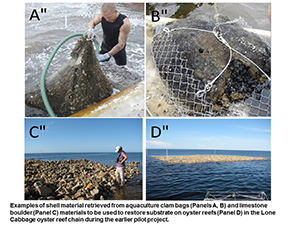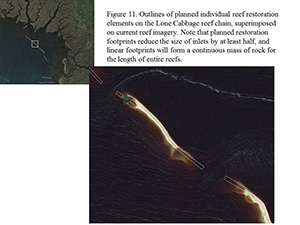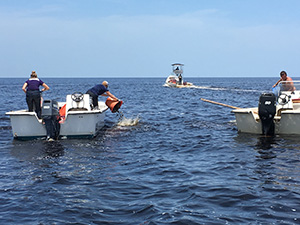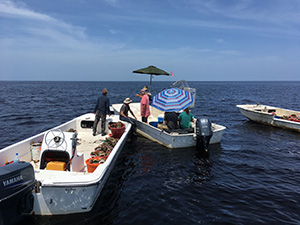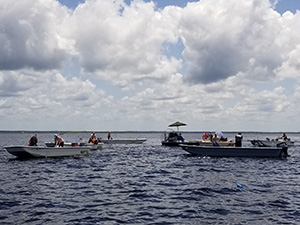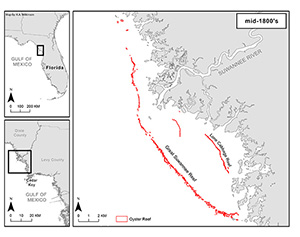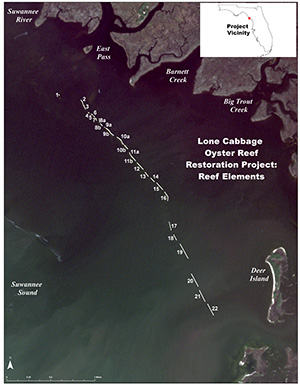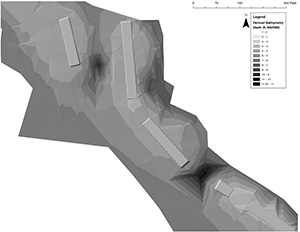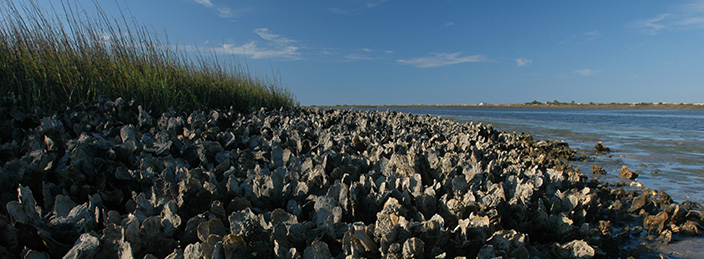
The Restoration Project
This project is funded by the National Fish and Wildlife Foundation using the Gulf Environmental Benefit Fund, one of the pots of money that comes from the Deepwater Horizon settlement. The GEBF fund is separate from funding that comes directly to Levy County from the Restore Act. The county funds may be used to rehabilitate oyster reefs for harvest. The goal of the GEBF project is to restore the entire Lone Cabbage reef chain, with the expected benefit of buffering the nearby coastal habitats from salinity fluctuations and erosion.
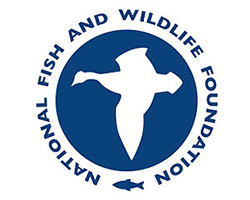

How should we restore the reef?
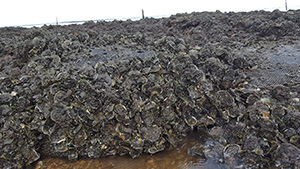
Working with a variety of stakeholders including NGOs, local oyster harvesters and clam farmers, and management agencies, we constructed a series of experimental reefs during 2011-2013 on Lone Cabbage to test approaches and materials for restoration. That study illustrated that by adding limerock boulders and shell material to the reef, we can (1) provide suitable surface for oysters to recruit to the reef, (2) increase elevations on the reef, (3) decrease inshore salinities by retaining fresh water that would otherwise be lost to the Gulf, and (4) likely reduce recovery time of oyster reefs following mortality events by providing stable a stable surface that does not wash away. In addition, there is strong evidence that we have created ideal habitat for juvenile blue crabs and many other oyster reef-dependent animals. These oyster mini-reefs were also very robust to storm and wave action, and did not move or degrade during Hurricane Hermine of 2016.
What will be done to restore the reef?
This new project will restore about 8 acres (nearly three linear miles) of oyster reef along the historic Lone Cabbage reef complex. Using knowledge gained from the pilot study, we plan to build the reef back to its historic footprint and elevation using limerock boulders as the base, and shell as the top-dressing. The rock comes from local quarries - it is the bedrock of the Big Bend coastal zone and often forms the base upon which natural oyster reefs have grown. The shell will come from the local aquaculture industry as much as possible. After construction, the reef will be approximately 1 - 2 feet higher than its current elevation, will be increased back to its original 3-mile length, and the inlets between reefs will be reduced from the current 200 - 400 foot gaps to 100 - 50 foot gaps. Collectively, these changes should make for both a restored reef, but also one that is more resilient to fluctuations in freshwater discharge and sea level rise.
How will we know if the restoration activities work?
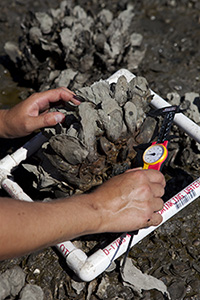
We predict that (1) the restored reef will initially attract more oyster settlement than unrestored sites, (2) the restored reef will retain more freshwater than if we did not restore it, and (3) that the restored reef will be able to recruit oysters and spring back after a drought faster than if we did not restore it. The first prediction was clearly fulfilled during the pilot study, and we will further test this by comparing the restored reef with nearby reefs that are left as they are. The second prediction about salinities can be examined by comparing salinities in Suwannee Sound before and after the restoration, and also comparing them on either side of the reef - the difference should be greater with the restored reef. Finally, we hope to do some hydrological modelling that will allow us to see how freshwater flows with and without restoration. The last prediction needs time - after the reef is built, we will compare oyster recruitment after a drought on both restored and unrestored reefs.
Who Will Conduct the Work?
This project involves collaboration between NFWF, Florida Fish and Wildlife Conservation Commission, and the University of Florida. The University of Florida will coordinate all work for the project. The overall lead for the project is Dr. Peter Frederick , with support from Dr. Bill Pine and Leslie Sturmer. The research coordinator for the project is Steve Beck. The project will also have educational opportunities for two graduate students each year as well as several technicians who will primarily focus their efforts on monitoring oyster population and salinity levels before, during, and after reef construction. Contractors, who will be in charge of placing the rock and covering the reefs with shell material, will conduct the majority of the work associated with the project. The onsite construction manager for the project is Mr. Tom Fillmer with the Brentwood Company in Newberry, Florida.
How Will the Work Be Done?
First, any live oysters in the construction footprint will be temporarily moved to a safe location nearby, and then returned to their original position after construction is complete. Local oystermen from region are leading this effort to move these oysters during June and July.
Then, using techniques that minimize draft of barges, we will place limerock boulders on the reef in a 30-foot wide swath, building the reef up to its original grade, and re-forming the inlets to their historic width.
Staging for the rock and barges will be in the town of Suwannee. The reef will not be a continuous "wall" of rock, but instead the reef will mimic a natural oyster bar made up of 22 smaller reefs of various sizes based on the footprint of the historic reef first surveyed in the 1800's.
The above map was developed based on information from USGS contained in this report
Raabe, E.A., Streck, A.E. and Stumpf, R.P., 2004. Historic topographic sheets to satellite imagery - A methodology for evaluating coastal change in Florida's Big Bend tidal marsh(No. 2002-211). US Geological Survey.
When complete it is predicted that the reef will function as a "leaky dam", holding fresh water inside Suwannee Sound, and creating more intermediate salinities.
The map below indicates the approximate location for each of the 22 reef elements.
Oyster reefs are refuges for small fish and shellfish, and young oysters in part because they have the small spaces that keep predators out. Large rocks are necessary to make sure the reef materials stay in place during storms - but large rocks mean large holes that predators can enter and consume young oysters and other organisms. To create the smaller spaces, we will fill in the holes between rocks with oyster or clam shell. This will be a thin scattering of shell, barely an inch deep on average - but enough to create the refuges that young oysters and other organisms need.
Gaps between each reef of various widths will create complex currents and habitats for oysters and oyster reef associated fish and invertebrates. The widest and deepest of these gaps will be marked with US Coast guard approved navigation signs. These will be in locations that have also been historically the most used by boaters.
This image is an example of the possible depth profile once construction is complete. Naturally occurring, deeper (dark color) "gaps" between the reef elements (rectangles, lighter color) are essential for the movement of water through Suwannee Sound.
The rocks used in the construction will be limestone from a quarry in the Suwannee River watershed to match the same type of limestone found naturally along the coast. Rock sizes will typically be about 18-24", with some larger rocks used on the edge of the reefs near the gaps to reduce the risk of erosion.


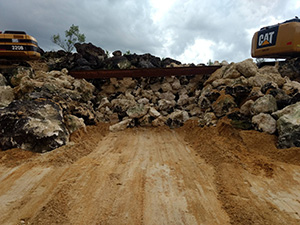
Rocks will be placed on the reef by using heavy equipment with a long boom arm based on the barge. The four corners of each reef will be marked using survey points and large floats. This will indicate where the rocks should be placed to create a specific part of the reef chain. After each small reef is built, the barge will move to the next reef element to the south and continue until the complete reef chain is built.
How is the money being spent?
Most of the project money (about 60%) will go directly to construction of the reefs which will probably take place in two parts. The first part would involve building the limerock reef base and the second part would involve collecting and adding the shell material to the reefs. The other major budget categories include permitting and design (surveys, engineering work), monitoring of oyster population and water quality responses before, during, and after construction, data analyses, outreach and education. There are also overhead costs associated with administering a large project like this. There is no "profit" made on a project like this funded by a grant to the University of Florida.
Community Involvement

This newly funded project was at least ten years in the making - starting with local community observations and concerns about disappearing oyster reefs in the Big Bend, progressing through research documenting the problem, a 3-year pilot construction project, and finally securing funding for a full-scale reef restoration project. All along the way local oystermen, the shellfish industry, state and federal partners, conservation organizations and community residents were all key to the success of each phase. How Can I Be Involved?
